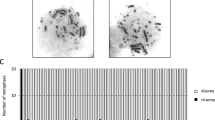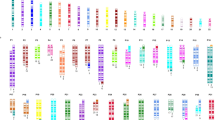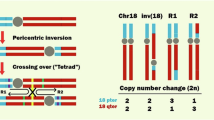Abstract
Non-allelic homologous recombination between chromosome-specific LCRs is the most common mechanism leading to recurrent microdeletions and duplications. To look for locus-specific differences, we have used microsatellites to determine the parental and chromosomal origins of a large series of patients with de novo deletions of chromosome 7q11.23 (Williams syndrome), 15q11–q13 (Angelman syndrome, Prader–Willi syndrome) and 22q11 (Di George syndrome) and duplications of 15q11–q13. Overall the majority of rearrangements were interchromosomal, so arising from unequal meiotic exchange, and there were approximately equal numbers of maternal and paternal deletions. Duplications and deletions of 15q11–q13 appear to be reciprocal products that arise by the same mechanisms. The proportion arising from interchromosomal exchanges varied among deletions with 22q11 the highest and 15q11–q13 the lowest. However, parental and chromosomal origins were not always independent. For 15q11–q13, maternal deletions tended to be interchromosomal while paternal deletions tended to be intrachromosomal; for 22q11 there was a possible excess of maternal cases among intrachromosomal deletions. Several factors are likely to be involved in the formation of recurrent rearrangements and the relative importance of these appear to be locus-specific.
Similar content being viewed by others
Log in or create a free account to read this content
Gain free access to this article, as well as selected content from this journal and more on nature.com
or
References
Shaw CJ, Lupski JR : Implications of human genome architecture for rearrangement-based disorders: the genomic basis of disease. Hum Mol Genet 2004; 13: R57–R64.
Emanuel BS, Shaikh TH : Segmental duplications: an expanding role in genomic instability and disease. Nat Rev Genet 2001; 2: 791–800.
Lopez Correa C, Brems H, Lazaro C, Marynen P, Legius E : Unequal meiotic crossover: a frequent cause of NF1 microdeletions. Am J Hum Genet 2000; 66: 1969–1974.
Miyake N, Kurotaki N, Sugawara H et al: Preferential paternal origin of microdeletions caused by prezygotic chromosome or chromatid rearrangements in Sotos syndrome. Am J Hum Genet 2003; 72: 1331–1337.
Tatton-Brown K, Douglas J, Coleman K et al: Multiple mechanisms are implicated in the generation of 5q35 microdeletions in Sotos syndrome. J Med Genet 2005; 42: 307–313.
Shaw CJ, Bi W, Lupski JR et al: Genetic proof of unequal meiotic crossovers in reciprocal deletion and duplication of 17q11.2. Am J Hum Genet 2002; 71: 1072–1081.
Saitta SC, Harris SE, Gaeth AP et al: Aberrant interchromosomal exchanges are the predominant cause of 22q11.2 deletions. Hum Mol Genet 2004; 13: 417–428.
Robinson WP, Dutly F, Nicholls RD et al: The mechanisms involved in formation of deletions and duplications of 15q11-q13. J Med Genet 1998; 35: 130–136.
Ensenauer RE, Adeyinka A, Flynn HC : Microduplication 22q11.2, an emerging syndrome: clinical, cytogenetic, and molecular analysis of thirteen patients. Am J Hum Genet 2003; 73: 1027–1040.
Lopes J, Vandenberghe A, Tardieu S et al: Sex-dependent rearrangements resulting in CMT1A and HNPP. Nat Genet 1997; 17: 136–137.
Baumer A, Dutly F, Balmer D et al: High level of unequal meiotic crossovers at the origin of the 22q11.2 and 7q11.23 deletions. Hum Mol Genet 1998; 7: 887–894.
Bayes M, Magano LF, Rivera N, Flores R, Perez Jurado LA : Mutational mechanisms of Williams–Beuren syndrome deletions. Am J Hum Genet 2003; 73: 131–151.
Dutly F, Schinzel A : Unequal interchromosomal rearrangements may result in elastin gene deletions causing the Williams–Beuren syndrome. Hum Mol Genet 1996; 5: 1893–1898.
Perez Jurado LA, Peoples R, Kaplan P, Hamel BCJ, Franke U : Molecular definition of the chromosome 7 deletion in Williams syndrome and parent-of-origin effects on growth. Am J Hum Genet 1996; 59: 781–792.
Robinson WP, Waslynka J, Bernasconi F et al: Delineation of 7q11.2 deletions associated with Williams–Beuren syndrome and mapping of a repetitive sequence to within and to either side of the common deletion. Genomics 1996; 34: 17–23.
Urban Z, Helms C, Fekete G et al: 7q11.23 deletion in Williams syndrome arise as a consequence of unequal meiotic crossover. Am J Hum Genet 1996; 59: 958–962.
Baumer A, Riegel M, Schinzel A : Non-random asynchronous replication at 22q11.2 favours unequal meiotic crossovers leading to the human 22q11.2 deletion. J Med Genet 2004; 41: 413–420.
Bonnet D, Cormier-Daire V, Kachaner J et al: Microsatellite DNA markers detects 95% of chromosome 22q11 deletions. Am J Med Genet 1997; 20: 182–184.
Chung MY, Lu JH, Chien HP, Hwang B : Chromosome 22q11 microdeletion in conotruncal heart defects: clinical presentation, parental origin and de novo mutations. Int J Mol Med 2001; 7: 501–505.
Demczuk S, Levy A, Aubry M et al: Excess of deletions of maternal origin in the DiGeorge/Velo-cardio-facial syndromes. A study of 22 new patients and review of the literature. Hum Genet 1995; 96: 9–13.
Edelman L, Pandita RK, Morrow BE : Low copy repeats mediate the common 3-Mb deletion in patients with velo-cardio-facial syndrome. Am J Hum Genet 1999; 64: 1076–1086.
Eliez S, Antonarakis SE, Morris MA, Dahoun SP, Reiss AL : Parental origin of the deletion 22q11.2 and brain development in velocardiofacial syndrome: a preliminary study. Arch Gen Psychiatry 2001; 58: 64–68.
Fokstuen S, Arbenz U, Artan S et al: 22q11.2 deletions in a series of patients with non-selective congenital heart defects: incidence, types of defects and parental origin. Clin Genet 1998; 53: 63–69.
Lu JH, Chung MY, Hwang B, Chien HP : Prevalence and parental origin in Tetralogy of Fallot associated with chromosome 22q11 microdeletion. Pediatr Cardiol 2001; 22: 279–284.
Morrow B, Goldberg R, Carlson C et al: Molecular definition of the 22q11 deletions in velo-cardio-facial syndrome. Am J Hum Genet 1995; 56: 1391–1403.
Trost D, Wiebe W, Uhlhaas S, Schwindt P, Schwanitz G : Investigation of meiotic rearrangements in DGS/VCFS patients with a microdeletion 22q11.2. J Med Genet 2000; 37: 452–454.
Vittorini S, Sacchelli M, Iascone MR et al: Molecular characterization of chromosome 22 deletions by short tandem repeat polymorphism (STRP) in patients with conotruncal heart defects. Clin Chem Lab Med 2001; 39: 1249–1259.
Carrozzo R, Rossi E, Christian L et al: Inter- and intrachromosomal rearrangements are both involved in the origin of 15q11-q13 deletions in Prader–Willi syndrome. Am J Hum Genet 1997; 61: 228–231.
Christian SL, Robinson WP, Huang B et al: Molecular characterisation of two proximal deletion breakpoint regions in both Prader–Willi and Angelman syndrome patients. Am J Hum Genet 1995; 57: 40–48.
Bolton PF, Dennis NR, Browne CE et al: The phenotypic manifestations of interstitial duplications of proximal 15q, with special reference to the autistic spectrum disorders. Am J Med Genet 2001; 105: 675–685.
Roberts SE, Dennis NR, Browne CE et al: Characterisation of interstitial duplications and triplications of chromosome 15q11–q13. Hum Genet 2002; 110: 227–234.
Somerville MJ, Mervis CB, Young EJ et al: Severe expressive language delay related to duplication of the Williams–Beuren locus. N Engl J Med 2005; 353: 1694–1701.
Yobb TW, Somerville MJ, Willatt L et al: Microduplication and triplication of 22q11.2: a highly variable syndrome. Am J Hum Genet 2005; 76: 865–876.
Hunt PA, Hassold TJ : Sex matters in meiosis. Science 2002; 296: 2181–2183.
Hassold T, Hunt P : To err (meiotically) is human: the genesis of human aneuploidy. Nat Rev Genet 2001; 2: 280–291.
Heilstedt HA, Ballif BC, Howard LA : Physical map of 1p36, placement of breakpoints in monosomy 1p36, and clinical characterization of the syndrome. Am J Hum Genet 2003; 72: 1200–1212.
Aldred MA, Sandford RO, Thomas NS et al: Molecular analysis of 20 patients with 2q37.3 monosomy: definition of minimum deletion intervals for key phenotypes. J Med Genet 2004; 41: 433–439.
Osborne LR, Li M, Pober B et al: A 1.5 million-base pair inversion polymorphism in families with Williams–Beuren syndrome. Nat Genet 2001; 29: 321–325.
Gimelli G, Pujana MA, Patricelli MG et al: Genomic inversions of human chromosome 15q11-q13 in mothers of Angelman syndrome patients with class II (BP2/3) deletions. Hum Mol Genet 2003; 12: 849–858.
Gebhardt GS, Devriendt K, Thoelen R et al: No evidence for a parental inversion polymorphism predisposing to rearrangements at 22q11.2 in the DiGeorge/Velocardiofacial syndrome. Eur J Hum Genet 2002; 11: 109–111.
Bi W, Park S-S, Shaw CJ, Withers MA, Patel PI, Lupski JR : Reciprocal crossovers and a positional preference for strand exchange in recombination events resulting in deletion or duplication of chromosome 17p11.2. Am J Hum Genet 2003; 73: 1302–1315.
Acknowledgements
This study would not have been possible without the cytogenetic staff of the Wessex Regional Genetics Laboratory, Salisbury, UK. We are also grateful to Mrs Barabra O'Prey for the recruitment of patient samples and to the Wellcome Trust for financial support.
Author information
Authors and Affiliations
Corresponding author
Rights and permissions
About this article
Cite this article
Thomas, N., Durkie, M., Potts, G. et al. Parental and chromosomal origins of microdeletion and duplication syndromes involving 7q11.23, 15q11-q13 and 22q11. Eur J Hum Genet 14, 831–837 (2006). https://doi.org/10.1038/sj.ejhg.5201617
Received:
Revised:
Accepted:
Published:
Issue date:
DOI: https://doi.org/10.1038/sj.ejhg.5201617
Keywords
This article is cited by
-
Sex-specific recombination patterns predict parent of origin for recurrent genomic disorders
BMC Medical Genomics (2021)
-
Optical mapping of the 22q11.2DS region reveals complex repeat structures and preferred locations for non-allelic homologous recombination (NAHR)
Scientific Reports (2020)
-
Pronounced maternal parent-of-origin bias for type-1 NF1 microdeletions
Human Genetics (2018)
-
Clinical Application of Chromosome Microarray Analysis in Han Chinese Children with Neurodevelopmental Disorders
Neuroscience Bulletin (2018)
-
Mosaicism for structural non-centromeric autosomal rearrangements in disease-defined carriers: sex differences in the rearrangements profile and maternal age distributions
Molecular Cytogenetics (2017)



